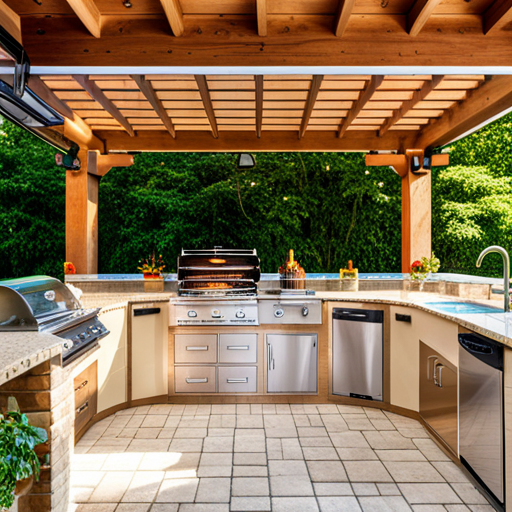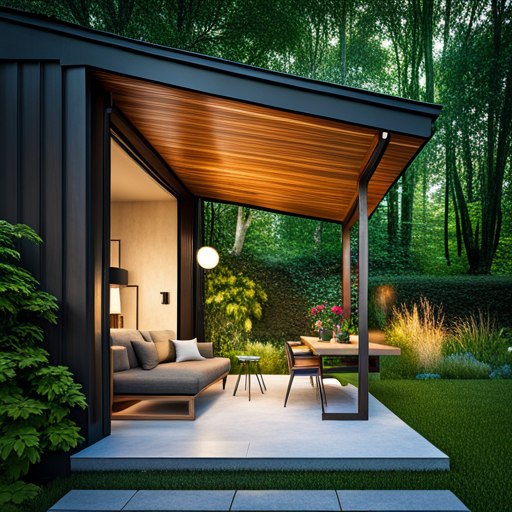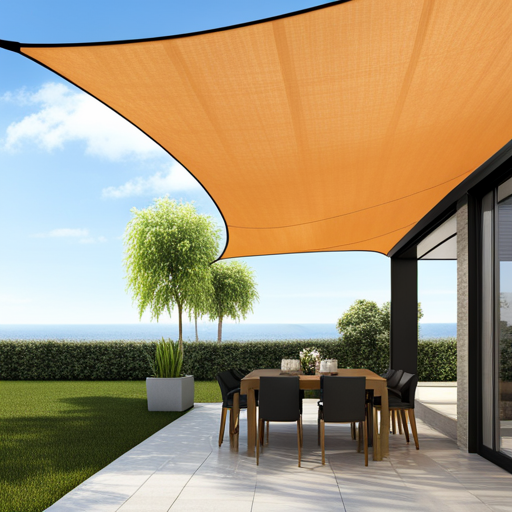Last Updated on June 19, 2024 by John Coleman
Introduction
So you have decided to make the exciting decision to upgrade your backyard or patio. You have done extensive research and decided on the perfect outdoor kitchen or perhaps an extravagant upgrade to an existing outdoor living area. These are fantastic additions to any backyard, but have you ever considered taking it a step further? Allow me to introduce you to the world of outdoor patio gazebos. These structures not only enhance your outdoor space aesthetically but also provide a whole range of functional benefits. In this guide, I have provided information along with images of gazebos to help you visualize the possibilities for your outdoor space to get the process going.
If you purchase through links on this site, we may earn a small commission. See our affiliate disclosure.
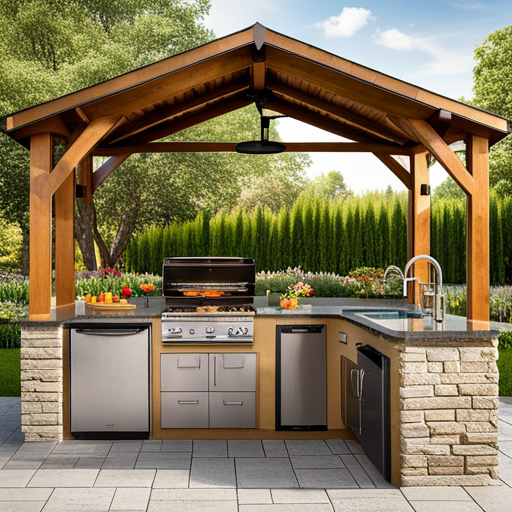
What Is An Outdoor Patio Gazebo?
An outdoor kitchen gazebo is a freestanding structure that is typically built in the backyard or garden to provide an outdoor dining and cooking area. It usually consists of a roof, pillars or posts, and open sides. The structure can vary in size and design depending on your personal preferences and the available space.
How Much Does an Outdoor Gazebo Cost?
The cost of an outdoor patio gazebo can vary greatly depending on its size, materials used, additional features, and whether you choose to DIY or utilize a contractor. According to an article posted on Bob Vila, “Gazebo cost typically falls between $2,831 and $9,613, with a national average cost of $5,763.” I have also found other research indicating you can expect to spend anywhere from $3,000 to $15,000 for a “basic gazebo”. However, if you opt for more high-end materials and customizations, the price can go up to $40,000 or more. If you are comfortable with DIY projects, choosing to DIY can significantly decrease the cost you would spend on labor and in some cases, materials.
Benefits of Choosing a Gazebo for Your Outdoor Kitchen
1. Protection from the Elements
One of the main benefits of opting for a gazebo is the added protection it provides. With a solid roof and sturdy walls, you can cook and entertain outdoors no matter what the weather throws your way—no more canceled barbeques or rushing inside when a sudden shower hits. A gazebo ensures you can enjoy your outdoor kitchen year-round.
2. Increased Privacy and Protection From Pests
Privacy may not be the first thing that comes to mind when thinking about an outdoor area, but it’s an important factor to consider. With a gazebo, you have the option of enclosing your space with walls or curtains, creating a more intimate and private setting. This is especially useful if you have close neighbors or if your backyard is visible to passersby. You may also choose to have a screened gazebo which decreases the annoyance of mosquitos and other insects.
3. Versatility
Gazebos offer a high level of versatility, making them suitable for a variety of purposes. In addition to housing your outdoor kitchen, they can also be used as an outdoor dining area, lounge space, or even a play area for kids. With the right design and planning, your gazebo can serve multiple functions and adapt to different needs.
4. Aesthetics
Let’s not forget the visual appeal of a gazebo. Its elegant structure and unique design add a touch of sophistication to any backyard. Plus, there are endless customization options available, from different roof styles to decorative features like lighting and built-in seating. A gazebo can truly elevate the overall look of your outdoor space.
5. Increased Home Value
Investing in a gazebo for your outdoor kitchen is not only beneficial in the present, but it can also have long-term benefits. Adding a permanent structure like a gazebo can significantly increase the value of your home, making it a wise investment for the future. Additionally, a well-designed and functional outdoor kitchen with a gazebo can be a major selling point for potential buyers.
Types of Outdoor Patio Gazebos
Outdoor patio gazebos come in a variety of styles and materials to suit every taste and budget. Here are some popular types you might consider:
Wood Gazebos
Wood gazebos bring a warm, natural charm to your outdoor kitchen. They are sturdy, durable, and blend seamlessly with the surrounding landscape. You can choose from a range of hardwoods such as cedar, pine, or redwood, depending on your preference. These gazebos also allow for customization, so you can add features such as built-in storage or seating.
Pros
- Aesthetic appeal: Wooden gazebos have a timeless, traditional appeal that brings warmth and elegance to your outdoor space.
- Durability: When properly maintained, wooden gazebos can last for many years. Certain types of wood, such as cedar or redwood, are particularly resistant to rot and insects.
- Customizability: Wood offers a great deal of flexibility for customization. You can easily add extra features, paint it any color you like, or carve intricate designs into the structure.
Cons
- Maintenance: Wooden gazebos require regular maintenance to retain their appearance and durability. This includes staining or painting every few years and periodic checks for rot or insect damage.
- Cost: Depending on the type of wood and the level of customization, wooden gazebos can be more expensive than those made from other materials.
- Environmental Impact: While wood is a renewable resource, the use of certain types of hardwoods can contribute to deforestation. Therefore, it’s important to choose wood that has been responsibly sourced.
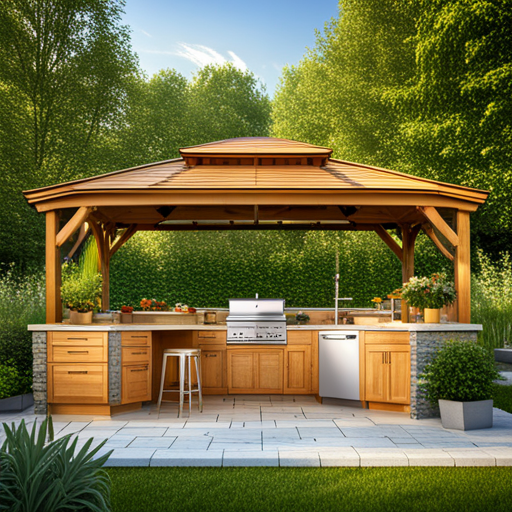
Metal Gazebos
For a modern and sleek look, metal gazebos are an ideal option. They offer a contemporary feel to your outdoor kitchen and come in various finishes like steel and wrought iron. These gazebos require less maintenance compared to wooden ones and are sturdier, making them a popular choice for windy areas.
Pros
- Low Maintenance: Metal gazebos don’t require staining or painting like wooden gazebos. They are also resistant to pests and rot, reducing the need for regular maintenance.
- Affordability: Compared to wooden gazebos, metal gazebos can be more affordable, depending on the type of metal used.
- Durability: Metal gazebos are known for their durability and strength, making them a good choice for areas with harsh weather conditions.
Cons
- Limited Customizability: While wooden gazebos offer flexibility for customization, metal gazebos have limited options as they can’t be easily altered or painted.
- Heat Absorption: Metal gazebos can get hot in the sun, making them uncomfortable to sit under during hotter months.
- Rust Potential: Depending on the type of metal used, there is a potential for rust over time, requiring maintenance to prevent further damage.
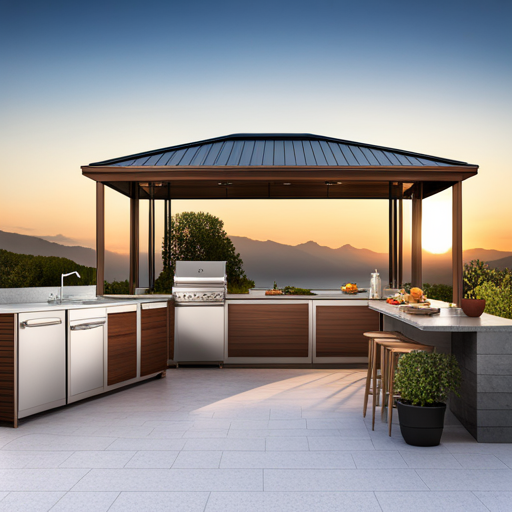
Aluminum Gazebos
Aluminum gazebos are lightweight, long-lasting, and rust-resistant. They offer a sleek and modern touch to your outdoor kitchen. They are also easy to install, making them a popular choice for DIY enthusiasts.
Pros
- Lightweight: Aluminum gazebos are lighter than other metal options, making them easier to transport and assemble.
- Low Maintenance: Similar to other metal gazebos, aluminum ones require minimal maintenance and are resistant to pests and rot.
- Affordability: Aluminum gazebos are more affordable compared to other metal options like wrought iron or steel.
Cons
- Not as Durable: While aluminum is a strong material, it may not be as durable as other metals, making it less suitable for harsh weather conditions.
- Limited Customizability: Like most metal gazebos, aluminum ones have limited options for customization and cannot be easily painted or altered.
- Heat Absorption: Aluminum, like other metals, will absorb heat during the spring and summer which can elevate the temperature for those sitting under it.
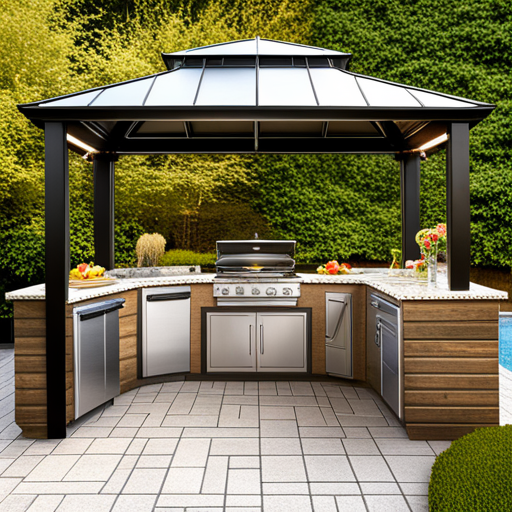
Flat Roof Gazebos
Flat roof gazebos offer a contemporary, minimalist look. They provide ample shade and are often easier to assemble and maintain.
Pros
- Easy to Assemble: Most flat roof gazebos come in easy-to-assemble kits, making them a popular choice for DIY enthusiasts.
- Sleek Design: Flat roof gazebos have a modern and sleek design that can add an elegant touch to your outdoor space.
- Ample Shade: The flat roof design offers ample shade, making it a comfortable and cool spot to relax in during hot summer days.
Cons
- Not Suitable for Rainy Areas: Flat roof gazebos are not recommended for areas with heavy rainfall as the flat surface can cause water to pool and potentially damage the structure.
- Less Sturdy: Compared to more traditional roof designs, flat roof gazebos may not be as sturdy and may require additional support in windy areas.
- Limited Air Circulation: Due to the flat design, these gazebos may have limited air circulation, potentially making them uncomfortable during hotter months.
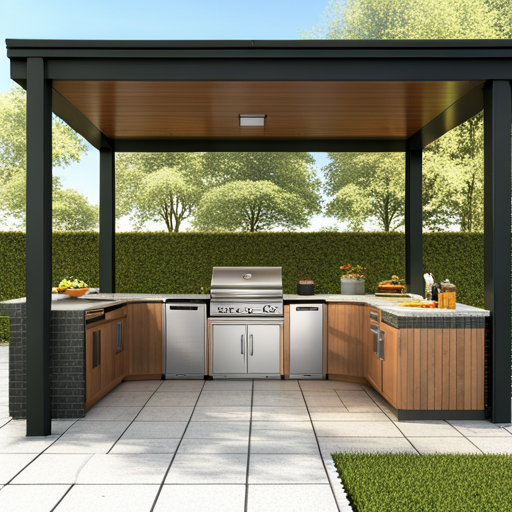
Hard Top Gazebos
Hard-top gazebos, typically made from metal or polycarbonate, are sturdy and provide excellent protection from the elements.
Pros
- Durable: Hardtop gazebos are extremely durable and can withstand harsh weather conditions, making them a long-term investment.
- Excellent Protection: The solid roof of hard-top gazebos offers protection from rain, snow, and strong winds, making it an ideal choice for outdoor entertainment.
- Customizable: Unlike other gazebo types, hard-top gazebos can be customized with additional features such as mosquito netting or curtains.
Cons
- Expensive: Hard-top gazebos tend to be more expensive than other options due to their durable materials and customizable features.
- Difficult to Assemble: Assembling a hard-top gazebo may require professional assistance, making it a more time-consuming and costly process.
- Limited Air Circulation: Similar to flat-roof gazebos, hard-top gazebos may also have limited air circulation, potentially causing discomfort during hotter months.
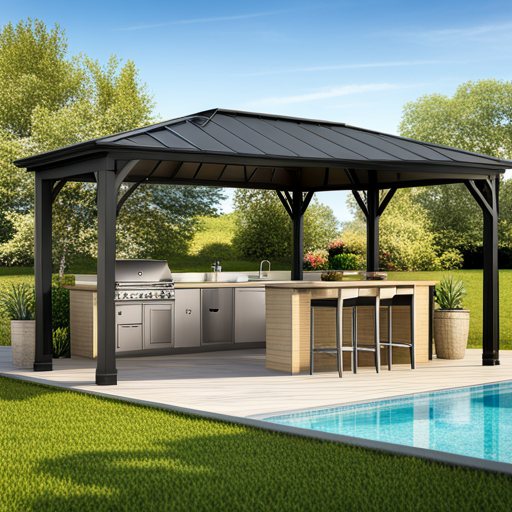
Rustic Gazebos
Rustic gazebos add a quaint charm to your backyard. Often made from wood, they create a cozy, natural ambiance for your outdoor kitchen.
Pros
- Natural Aesthetics: Rustic gazebos add a natural, rustic charm to any backyard, making it an appealing choice for those who prefer a more traditional and cozy feel.
- Affordable: Compared to other gazebo types, rustic gazebos tend to be more affordable due to their simpler design and use of less expensive materials.
- Easy to Assemble: With a simpler design, rustic gazebos are easier to assemble and can often be done without professional assistance.
Cons
- Less Durable: Rustic gazebos may not be as durable as hard-top or polycarbonate options, making them less suitable for harsh weather conditions.
- Maintenance Required: Due to the use of wood, rustic gazebos may require regular maintenance such as staining or sealing to prevent rot and decay.
- Limited Features: Unlike hard-top gazebos, rustic options do not offer customizable features such as mosquito netting or curtains
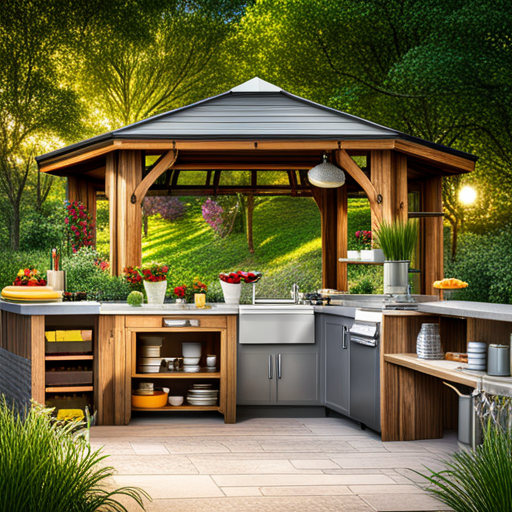
Octagon Gazebos
Octagon gazebos, with their distinctive eight-sided shape, make a statement in any outdoor space. They offer ample space for your outdoor kitchen.
Pros
- Unique Design: Octagon gazebos have a unique and eye-catching design, adding interest and character to your backyard.
- Spacious: With eight sides, octagon gazebos provide more space for your outdoor kitchen compared to other shapes.
- Sturdy Construction: Octagon gazebos are typically made with durable materials like wood or metal, making them suitable for various weather conditions.
Cons
- Higher Cost: Due to their unique design and larger size, octagon gazebos may be more expensive than other gazebo types.
- More Challenging to Assemble: The multiple sides and angles of an octagon gazebo can make it more challenging to assemble compared to simpler designs.
- Limited Shape Options: As an eight-sided structure, octagon gazebos may not provide the flexibility of shape that some other types do for fitting into specific spaces.
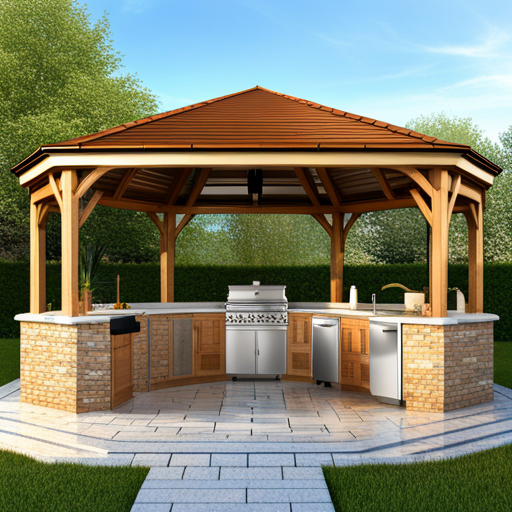
Building From Scratch vs. Utilizing a Gazebo Kit
When it comes to adding an outdoor kitchen gazebo to your backyard, you have the option of building it from scratch or using a kit. Here are some pros and cons to consider for each approach.
Building From Scratch
Pros:
- Customizable: By building from scratch, you have complete control over the design and can customize it to fit your specific needs and preferences.
- Cost Savings: Depending on the materials you choose, building from scratch can be more cost-effective than purchasing a pre-made kit.
- Satisfaction of DIY: Building your own outdoor kitchen gazebo from scratch can be a rewarding and satisfying experience for those who enjoy DIY projects.
Cons:
- Time Consuming: Building from scratch requires more time and effort compared to using a kit, which may not be ideal for those with busy schedules.
- Requires Advanced Skills: This approach may not be suitable for beginners or those without the necessary carpentry skills, as it can be a complex project.
- Possible Errors: Without proper planning and execution, there is potential for mistakes or errors that could impact the functionality and safety of the gazebo.
Utilizing a Kit
Pros:
- Simpler Assembly: Gazebo kits come with pre-cut materials and detailed instructions, making it easier for individuals with basic carpentry skills to assemble.
- Faster Construction: Using a kit can significantly reduce construction time compared to building from scratch, which may be beneficial for those with time constraints.
- Less Planning Required: With a kit, most of the design work is already done for you, saving time and effort in the planning process.
Cons:
- Limited Customization: While some kits offer customization options, they are often limited compared to building from scratch.
- Quality of Materials: The quality of materials in a kit may not be as durable or long-lasting as those chosen individually, potentially affecting the longevity of the gazebo.
- Higher Cost: Depending on the size and design, purchasing a kit can be more expensive than building from scratch with carefully selected materials.
Ultimately, the decision between building a gazebo from scratch or utilizing a kit depends on individual preferences and skill level. For those with advanced carpentry skills who value customization and are willing to invest time and effort, building from scratch may be the preferred option. However, for individuals with limited time and basic skills looking for a more convenient and faster approach, using a kit may be the better choice. It’s important to carefully research and compare options before making a decision, considering factors such as cost, customization, and quality of materials. Additionally, seeking advice from experienced individuals or professionals can also help in making an informed decision.
Where to Buy Gazebo Kits
When considering purchasing a gazebo kit, there are various options available. Here are some popular places to buy gazebo kits:
Online retailers: Websites such as SunJoy Group, Purple Leaf, and Amazon also have a wide selection of gazebo kits available for purchase.
Home improvement stores: Some local home improvement stores may offer a variety of gazebo kits in different sizes and designs.
Specialty gazebo retailers: There are also specialty retailers that specifically sell gazebo kits, offering a larger variety of options and potentially higher quality materials.
Local carpenters or craftsmen: Some local carpenters or craftsmen may also offer custom-made gazebo kits, providing the opportunity for customization and potential cost savings.
Key Differences: Gazebo vs. Pergola
Many people use the terms “gazebo” and “pergola” interchangeably, but they are distinct structures. A gazebo is a freestanding structure with a roof and open sides, while a pergola is an outdoor structure with columns and an open lattice roof. Here are some other key differences:
- Function: Gazebos are often used for dining or lounging, while pergolas can also serve as walkways or garden features.
- Roof: Gazebos have a solid roof, while pergolas have an open lattice roof.
- Shade: Gazebos provide more shade due to their solid roof, while pergolas offer partial shade.
- Materials: Gazebos are typically made from wood or metal, while pergolas can be made from a variety of materials such as wood, vinyl, or aluminum.
- Cost: Gazebos tend to be more expensive due to their solid roof, while pergolas can be more budget-friendly.
- Installation: Whether built from scratch or a kit, gazebos are often more complex to install because they have a solid roof which means there will be more pieces. Pergolas, on the other hand, can be easily assembled with prefabricated kits and are typically (depending on your design) more easily built from scratch.
Overall, both are great options for adding functional and aesthetic value to your outdoor space. Consider your specific needs and preferences when choosing a structure that is right for you. These outdoor structures will surely enhance your backyard experience. If you would like more information about pergolas, check out my post that specifically discusses pergolas.
Conclusion
In conclusion, outdoor patio gazebos are popular outdoor structures that offer a variety of functions and aesthetic appeal. Regardless of which type of gazebo you choose, it is important to keep up with regular maintenance to ensure it stays in good condition. With the beautiful weather and endless options for customization, a gazebo can take your outdoor experience to the next level.
Frequently Asked Questions
Q: What materials are gazebos typically made from?
A: Gazebos are often made from wood, metal, or vinyl. The material can greatly impact the look, durability, and maintenance requirements of the gazebo.
Q: How do pergolas differ from gazebos?
A: Pergolas are typically more open than gazebos and have a flat, lattice-style roof. Gazebos, on the other hand, have a solid roof and offer more protection from the elements.
Q: Can I install a gazebo or pergola myself?
A: While it’s certainly possible for a handy homeowner to install a pergola, particularly if it comes in a prefabricated kit, gazebos can be more complex to install and may require professional help.
Q: What maintenance is required for gazebos?
A: Regular maintenance for these outdoor structures often includes cleaning, treating, or painting the structure (particularly if it’s made of wood), and checking for any damage or signs of wear and tear.
Q: How can I choose between a gazebo and a pergola for my outdoor kitchen?
A: The choice between a gazebo and a pergola depends on your specific needs and preferences. Consider factors such as your budget, the amount of shelter you desire, and the aesthetic you’re aiming for in your outdoor kitchen.
See Also:
A Guide to Design a Low-Budget DIY Outdoor Kitchen
Transform Your Outdoor Kitchen with a Pergola: A Comprehensive Guide and Practical Advice
If you purchase through links on this site, we may earn a small commission. See our affiliate disclosure.


